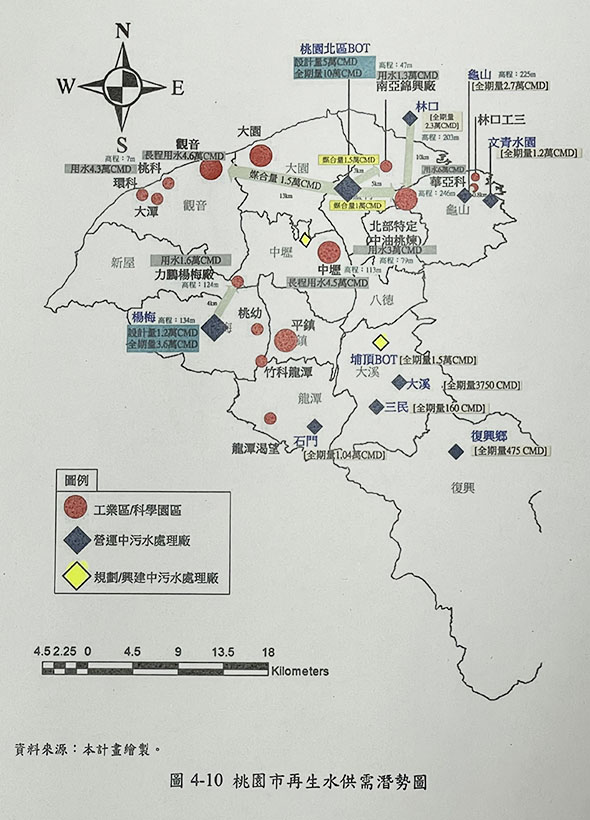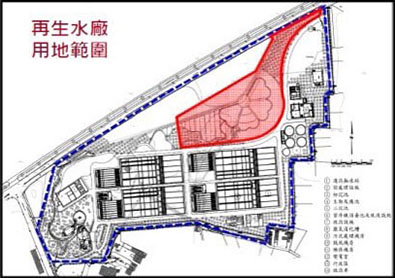 Show Topic
Show Topic
 Taoyuan City Water Reclamation Plan and Sewage Treatment Centers
Taoyuan City Water Reclamation Plan and Sewage Treatment CentersU.N. water sector declared in their 2017 annual report that wastewater should not be seen as a problem but a valuable resource.
Water is always in movement on earth in the natural environment, also known as the hydrologic cycle. As civilization advances, human development and the consequent pollution cause damage to the environment and clean water gradually becomes depleted. Global warming brought extreme weather, and natural disasters such as flood and drought to the world, further diminishing the already scarce clean water source. This is where water reclamation technology comes in. It stands in as a new link in the dysfunctional natural water cycle, making effluent useful again as a supplement to existing water source.
Taoyuan City supervises over nine rivers running across the city region and Taham River as commissioned by the central government. The city landscape is dotted with numerous ponds and canals, befitting the name Home to A Thousand Ponds. The history and culture of Taoyuan are closely connected to its special hydrological regime. The socio-economic development and population growth makes water treatment plants and centers as the top priority task on city development. Presently, there are 10 Sewage Treatment Centers within Taoyuan city, namely, the Taoyuan Northern District, Guishan, Daxi, Airport MRT A7 Station, Luofu, YiSheng, FuXing, SanMing, ShiMen, and YangMei, respectively.
Where does reclaimed water, or the so-called blue gold go? The primary goal is to ensure a stable water supply for industrial use. Deputy Director-general of the Department of Water Resources, Jin-Jing Lee, stated that Oriental Petrochemical, Guanyin Industrial Park, and Taoyuan Aerotropolis are all target users and signed customers of the Taoyuan Northern District Sewage Treatment Center. The center is the first reclaimed water plant in the Northern Taiwan, and will be invested, constructed and operated by CTCI Co., Ltd. and Radium Life Tech. Co., Ltd., and is estimated to process 40 thousand tons of reclaimed water in the initial period, and 110 thousand tons overall. Airport MRT A7 station Center is set to provide 5300 tons of reclaimed water for the semiconductor suppliers at Hwa Ya Technology Park. The Zhongli Center is still under construction. It is estimated to produce 30 thousand tons of reclaimed water in the initial period and 80 thousand overall. Zhongli Center and the Taoyuan Northern District Center form a reclaimed water supply network for industrial parks along the coast and the industrial area at aerotropolis.
 The area valid for irrigation by Yang Mei Sewage Treatment Center
The area valid for irrigation by Yang Mei Sewage Treatment Center
Another innovative approach worth mentioning is reusing treated effluent by irrigation. Lee proudly states that "Taoyuan is the first city in Taiwan to advocate effluent reuse by irrigation as irrigation takes up 71% of total water usage in Taiwan. 10% of water by irrigation is from reservoirs, 9% from underground water, 66.5% from rivers, and the rest from other water storage facilities. Using effluent by irrigation can lighten the load on reservoirs and allow room for other arrangements." In addition, many sewage treatment centers are located within proximity of farmlands, giving irrigation extra lure for potential recycled wastewater disposal. The effluent recycled by YangMei Sewage Treatment Center will be able to irrigate 3.2 hectares of paddy rice farming in the initial stage. The total volume may increase if the source of effluent increases. This paradigm may make more space for Shimen Reservoir and hopefully be of example to all the other cities in Taiwan.
Reclaimed effluent by irrigation comes mainly from domestic wastewater. The water does not contain heavy metal. Though the level of ammonia nitrogen concentration is higher than standards, the rest of the indicators are in line with agricultural irrigation standards. In fact, ammonia nitrogen acts as fertilizer for crops and plants. Using reclaimed water by irrigation will reduce the need for additional chemical fertilizers. The act lowers the cost for farming, reduces carbon emission and serves as an extra source for underground water supply. Though the entire program is still under pilot testing, the crops produced by paddy fields, greenhouses, and hydroponic systems irrigated by recycled effluent are all of excellent quality. The vegetables can even be consumed with minimal treatment as they passed the tests for uncooked and raw food hygiene standards.
Lee believes that sustainability is the key to modern water resource planning. For example, the bank of Tahan River will serve as an optimal low usage ecological walk. The highly congregated ponds in the area can be turned into an ecological park that also doubles as a water storage facility. Nurturing a sustainable ecological environment and introducing reclaimed water for human activities all pertain to the understanding that, "Protect water resource and allow nature to run its course is the way to a sustainable ecosystem."
Department of Water Resources , Taoyuan
Booth: A0606
 The Taoyuan Northern District Sewage Treatment Center
The Taoyuan Northern District Sewage Treatment Center




